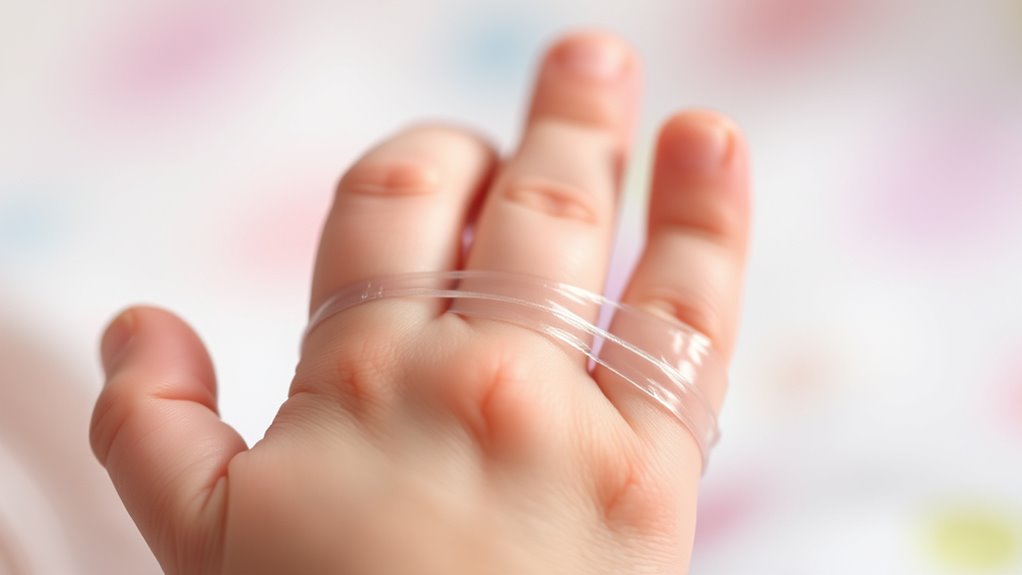Amniotic Band Syndrome (ABS) happens when fibrous strands from the amniotic sac wrap around a developing fetus. It can restrict blood flow, leading to serious issues like limb deformities, clubbed feet, or even cleft palate. Although it’s not genetic, its effects can vary greatly in severity. Diagnosis is often made at birth, and treatment may involve surgeries or prosthetics afterward. There’s a lot more to uncover about its implications and management.
Key Takeaways
- Amniotic Band Syndrome (ABS) occurs when damaged amniotic sac lining creates fibrous strands that entangle a developing fetus.
- ABS can lead to congenital malformations, including limb deformities like clubbed feet and cleft palate.
- Diagnosis typically occurs at birth, as ABS is challenging to detect via routine ultrasounds.
- Treatment often involves postnatal surgery, prosthetics, and rehabilitation for affected limbs.
- Prognosis varies widely, with improved outcomes due to early intervention and specialized care.

Amniotic Band Syndrome (ABS) occurs when the amniotic sac’s lining gets damaged, leading to fibrous strands that can entangle a developing fetus. Also known as amniotic band disruption or constriction ring syndrome, this condition isn’t considered genetic; it’s more like a chance event during pregnancy. The exact cause of the damage to the amniotic sac remains unknown, but it affects approximately 1 in 1,200 to 15,000 live births, making it a relatively rare occurrence.
When these fibrous bands form, they can restrict blood flow to various parts of the fetus, potentially leading to a range of congenital malformations. You might notice common effects such as limb deformities, clubbed feet, and even cleft palate. In severe cases, the consequence could be amputation or other life-threatening complications. The severity of ABS largely depends on the location and tightness of the bands, with milder cases causing only skin indentations.
Diagnosing Amniotic Band Syndrome typically happens at birth because it’s hard to detect the bands during routine ultrasounds. Sometimes, advanced imaging like MRI can assess the severity of the situation. While ultrasounds can sometimes pick up signs of ABS during the 20-week anatomy scan, early detection is often challenging yet crucial for planning care. A fetal echocardiogram may also be used to evaluate heart function if needed.
Treatment usually involves postnatal surgery to correct deformities caused by the bands, but prosthetics and rehabilitation may also be necessary for limb loss or dysfunction. In severe cases, fetal surgery can help prevent further damage, although the decision to proceed with that option involves assessing various risks. Thankfully, advances in 3D printing have significantly improved prosthetic options for affected children.
Complications associated with ABS can include premature birth, increased risk of miscarriage, and stillbirth. Severe constriction can lead to organ damage or amputation, especially if the bands wrap around vital areas like the umbilical cord. While children with ABS might require long-term physical or occupational therapy, the condition doesn’t pose any increased risk to the mother during pregnancy.
Monitoring fetal development through regular ultrasounds is key to managing ABS. A detailed assessment is essential for considering fetal surgery, and collaboration with specialized fetal treatment centers can make a difference. The prognosis varies widely depending on the severity, but early intervention and advances in treatment have greatly improved long-term outcomes for children with ABS.
Frequently Asked Questions
Can Amniotic Band Syndrome Be Inherited From Parents?
You might wonder if amniotic band syndrome can be inherited from parents.
While there’s some evidence suggesting a genetic predisposition, it’s generally not considered hereditary. Most cases appear randomly, without a clear genetic link.
If you have a first-degree relative with the condition, your risk may be slightly higher, but specific genes haven’t been identified.
It’s more about complex interactions between genetic and environmental factors during pregnancy.
What Are the Long-Term Effects of Amniotic Band Syndrome?
Did you know that around 80% of cases involving limb involvement have excellent long-term outcomes?
When you consider the effects of amniotic band syndrome, you’ll find that severity plays a crucial role. Many children with limb defects thrive, while those with severe complications affecting vital organs may face significant challenges.
Regular monitoring and surgical interventions can enhance quality of life, but the prognosis varies widely depending on the specific conditions involved.
Is There Any Way to Prevent Amniotic Band Syndrome?
You can’t completely prevent Amniotic Band Syndrome, but you can take steps to minimize risks.
Regular prenatal check-ups and ultrasound monitoring help catch potential issues early. If there’s a family history of ABS, consider genetic counseling.
Maintaining a healthy lifestyle during pregnancy is also crucial.
How Is Amniotic Band Syndrome Diagnosed During Pregnancy?
Diagnosing amniotic band syndrome during pregnancy can feel like trying to find a needle in a haystack!
You’ll typically undergo routine ultrasounds, which may reveal the presence of amniotic bands. If needed, doctors might recommend advanced imaging techniques like fetal MRIs or echocardiograms to assess severity.
Regular monitoring is crucial, allowing your healthcare team to track fetal growth and plan for any necessary interventions or specialized care throughout your pregnancy.
What Support Resources Are Available for Families Affected by Amniotic Band Syndrome?
If you’re looking for support resources for families affected by a birth defect, there are many options available.
Organizations like March of Dimes and Birth Defect Research for Children offer vital information and networking opportunities.
You can also find emotional support through child life specialists and family resource centers.
Don’t hesitate to join support groups for shared experiences, and explore counseling services to help manage the emotional challenges you might face.
Conclusion
In conclusion, understanding Amniotic Band Syndrome is crucial, as it sheds light on the intricate dance between nature and development. While it can lead to challenges, the resilience of those affected often shines through like a beacon of hope. By raising awareness and fostering support, you’re not just learning about a condition; you’re embracing the strength that comes from adversity. After all, it’s in the face of difficulties that the most beautiful stories are often written.









